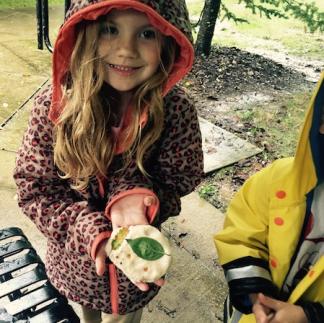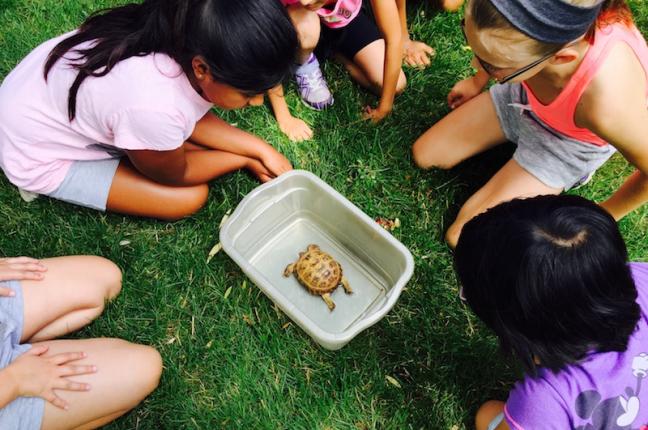Member Spotlight
City of Dublin, Ohio

Dublin, OH, is committed to providing the best quality of life and environment to its 40,000+ residents. We were intrigued to learn about the city's many nature-based programs for young children and asked Barbara Ray, Dublin's Nature Education Coordinator, to tell us more about them!
In the description of your organization on our Member Map, you wrote that "It's Greener in Dublin" sums up the city's dedication to its mission of healthy place and space. Can you tell us how programs or spaces for your youngest residents and their families fit into this mission?
We are and always have been a proud local democracy. In our service, we strive to provide the best quality of life and environment in which our residents and business can thrive. We seek to ally our proud traditions with the best innovations of the future.
Dublin maintains 60 public parks designed for families with children of all ages to access nature, play, explore, and increase health and wellness through outdoor activity and informal programming.
Many of our programs are designed specifically for young children with hands-on discovery, games, and experiences that encourage collaboration, creativity, and problem solving as well as provide opportunity to enhance motor skills and self-awareness. Programs are developed to meet the needs of a diverse audience and are all inclusive to provide fun, meaningful experiences for the wide range of cultures and abilities of children and families that make up both Dublin and visiting residents who come to our parks, open space, and programs.
Much of our focus in Dublin as a green city is promoting peaceful co-existence with wildlife and compassion for all living things. This theme, this way of life is reflected throughout nature programming in the city.

What are some of the environmental education programs you offer around Dublin, especially at the early childhood level?
Popular programs for our youngsters are interactive outdoor hikes that include a science-discovery activity and often a creative arts component. Usually very little instruction is given, so that the children are free to come up with their own interpretations and choices as to how they want to engage the activity.
Wild Art in the Park is a seasonal hike that may focus on wildlife or trees or a scavenger hunt, followed by the children collecting natural items that appeal to them, such as leaves, twigs, pebbles, pine cones, soil and anything else they love to touch. They then create a "natural art" piece or perhaps a sculpture. This “earth art” will stay in the park, so we take photos in order to preserve their work. The children create amazing designs and artwork!
Treemendous is a program the children love as they learn how to estimate the age of a tree. Children are given a length of string to find the circumference of a tree of their choice. Then, they lay out the string and measure it with a measuring tape. To age a tree, we need the diameter, so they divide the circumference by pi using a calculator. Once they identify the tree species, they use a chart to determine a factor of 1-5 to multiply by to estimate its age. This is a great activity for parents to mentor their youngsters as well, and sometimes an older sibling will help the youngest children to complete the activity.
Bubbles in the Park is a program where the children first experiment with water, water tension and make bubble soap through a series of simple tests. They then make both small and large hoop bubbles. Even the parents get into this activity to try and make the largest bubbles!
Gardening by the River is very popular with very young children as they play in soil and water and create their own native flower and herb planters. Often a very young participant may decide to just grab a hand spade and scoop soil into planters and transfer to another planter and he or she may do this for the entire session. But the motor skills developed during this “play” and the joy experienced by that child are exactly why we want to provide these programs!
Amazing Adaptations focuses on the adaptations of our wild neighbors and safety during wildlife encounters. Through use of biofacts, live animal visitors, and hands-on role playing, children begin to understand how animals are adapted to behave in certain ways, and by practicing HOW to respond in an animal encounter, children are better prepared to avoid a dangerous interaction with any animal. Children also learn ways to prevent tick and mosquito bites as well as the safe way to remove ticks.
In 2017, we piloted a program through Recreation Services called DiRECt to You, Neighborhood Parks. These are nature and wellness programs ranging from hiking to yoga to nature play offered in neighborhood parks that sign up to participate. If adults may be participating in outdoor yoga, we have a wildlife program at the same time for their children. Over 25 programs were offered in 2018. Residents may see the DiRECt van driving around Dublin as it visits various parks throughout the year!

At Natural Start, we encourage our members to make nature-based opportunities available to every child. How do you make sure that your programs are accessible to children with physical disabilities, and are relevant and inclusive to all?
Dublin has an Adaptive Recreation Coordinator and instructors work with that person to ensure programs meet the needs of all participants. Extra staff is provided if needed to assist a participant with the program and we offer programming in locations that are accessible. Any resident or teacher or group can inquire about setting up a parks program with the Nature Education Coordinator and, as accessibility needs are expressed, programs can be further adapted. Also, during program planning, we utilize the input and evaluations provided by participants and parents to develop activities that are interesting and relevant to them.
What are some tips you would give to other cities who want to support early learning in and with nature?
Children crave connection with the outdoors. Plan programs in a way to give them freedom to explore in their own way as much as possible. Give them a task or idea and set them loose to complete that and make many of their own discoveries. Do not be afraid of science and big words! We use the language of biology and science and then let them explore what those words mean. Set up STEAM activities that are age appropriate, but they are never too young to start playing with the idea of asking a question, testing and collecting and then reaching a conclusion. Watch a young child grab a handful of small pebbles to estimate how many it will take to break the water tension at the surface of a cup so the water finally flows over! Then watch the same child extrapolate that it will require far fewer large pebbles to create the same result!
Not sure where to start? Collaborate with others!
- Connect with local metro parks naturalists and educators in nearly any environmental field. Most Soil and Water Conservation Districts and state Natural Resources Departments provide many resources as well! Look up some forest school curriculums and teachers who may be in your area.
- There are many great resources on the web such as the Natural Start Alliance, National Wildlife Federation, Monarch Watch, local arboretums and zoos.
- Other cities are always welcome to contact the City of Dublin as well! Myself and many other parks and recreation professionals are engaged with young children to offer health and wellness opportunities through nature and outdoor experiences!



